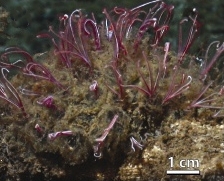|
Osedax Antarcticus
''Osedax'' is a genus of deep-sea siboglinid polychaetes, commonly called boneworms, zombie worms, or bone-eating worms. ''Osedax'' is Latin for "bone-eater". The name alludes to how the worms bore into the bones of whale carcasses to reach enclosed lipids, on which they rely for sustenance. They utilize specialized root tissues for bone-boring. It is possible that multiple species of ''Osedax'' reside in the same bone. ''Osedax'' worms are also known to feed on the collagen itself by making holes in the whale's skeletal structure. These holes can also serve as a form of protection from nearby predators. Scientists from the Monterey Bay Aquarium Research Institute using the submarine ROV ''Tiburon'' first discovered the genus in Monterey Bay, California, in February 2002. The worms were found living on the bones of a decaying gray whale in the Monterey Canyon, at a depth of . Anatomy and physiology Lacking stomach and mouth, ''Osedax'' rely on Symbiosis, symbiotic species of ba ... [...More Info...] [...Related Items...] OR: [Wikipedia] [Google] [Baidu] |
Osedax Roseus
''Osedax roseus'' is a species of bathypelagic polychaete worm that lives at abyssal depths and is able to sustain itself on the bones of dead whales. The species is found in the North East Pacific. Behavior When a whale dies, its carcass falls to the seabed. Here it provides a feast for many deep-sea invertebrates. Worms such as ''Osedax roseus'' make use of the bones when only the skeleton remains. The worms produce a branching network of "roots" which house symbiotic bacteria which enable the worms to utilise the bones' nutrient content. This worm was first described from a whale carcase that fell to the seabed in Monterey Bay, California Monterey Bay is a bay of the Pacific Ocean located on the coast of the U.S. state of California, south of the San Francisco Bay Area and its major city at the south of the bay, San Jose. San Francisco itself is further north along the coast, by a ..., settling at a depth of . Time lapse photography shows that female ''Osedax roseus'' were ... [...More Info...] [...Related Items...] OR: [Wikipedia] [Google] [Baidu] |
